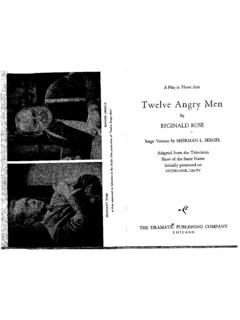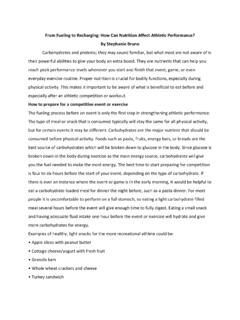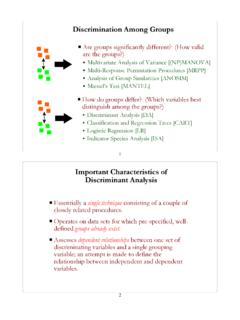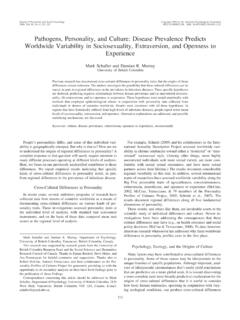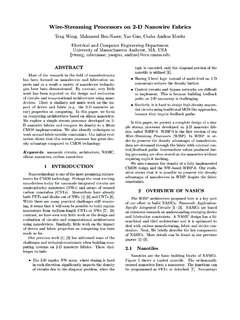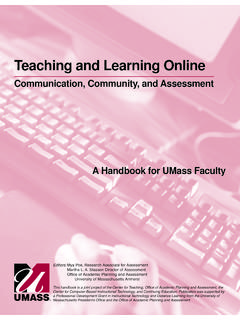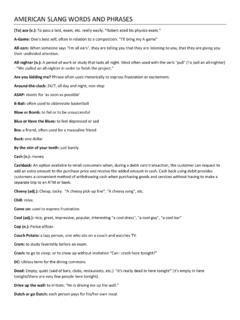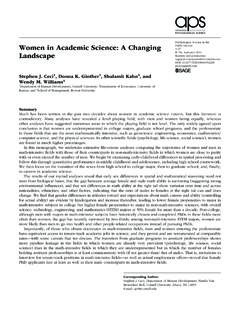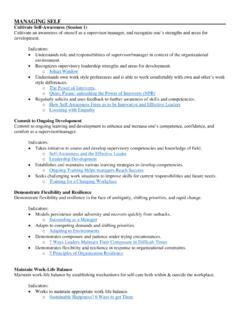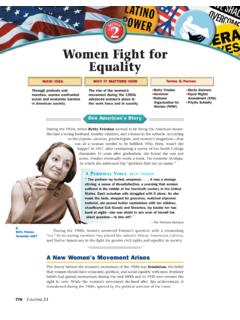Transcription of The Problem of Truth: Discussion of a Lawyer’s Duty
1 The Problem of truth : Discussion of a Lawyer s DutyThere is an inherent flaw in the United States criminal justice system. Theadversarial nature of formal dispute resolution upon which our common law system isbased often fails to provide American citizens with justice. Clearly justice can be definedin a litany of different ways, and justice cannot be regarded as one definite, universallyaccepted ideal. For the purposes of this Discussion , however, the function of criminaltrials in the will be defined in the most basic of terms: the discovery of the truth in agiven situation through due process of law, such that those who are guilty of crimesdelineated by codified laws are punished through fines, incarceration, and otherestablished reprimands. This truth , however, is sometimes not reached in trials, and theadversarial system is often to blame for this failure. More specifically, it is the roll thatattorneys play within this system in which it is the duty of these officials only to wincases with any means legally possible, not to aid the discovery of true facts that impedesthe system s ability to uncover the truth in matters.
2 Thus, the adversarial roll of lawyerswithin the legal system obstructs the pursuit of discovering who, in fact, is innocent, andwho is guilty in legal disputes and trials, effectively hindering the system s ability toachieve its purpose in the aforesaid has argued that when two men opposite is certainthat no important consideration will altogether escape notice. 1 However, in thepresenting of these considerations through exhibits and testimonies, lawyers oftenattempt to question their validity, thus distorting the legitimacy of any evidence that aJury or Judge is introduced to. According to Jerome Frank: 1 Jerome Frank, The Fight Theory Versus the truth Theory (Princeton University Press;1976) ..the partisanship of the opposing lawyers blocks the uncovering of vital evidence orleads to a presentation of vital testimony in a way that distorts have allowed the fightingspirit to become dangerously short, the lawyer aims at victory, at winning in thefight, not aiding the court in discovering facts.
3 He does not want the trial court to reach a soundand educated guess, if it is likely to be contrary to his client s interest. Our present trial method isthus the equivalent of throwing pepper in the eyes of a surgeon when he is performing 2 For many lawyers, procedure often takes precedence over truth in trials. Even if theyknow their client is guilty, an attorney may still legally make efforts to delegitimize thecase of the prosecution. Frank states: an experienced lawyer uses all sorts of stratagemsto minimize the effect on the judge or jury of testimony disadvantageous to his client,even when the lawyer has no doubt of the accuracy and honesty of the testimony. 3 Inthis sense, lawyers work directly against the pursuit of justice, using skill and knowledgeof the legal system to skew the discovery of their client s guilt. The only means withwhich to discover the truth are facts and testimonies presented by lawyers andprosecutors, and creating confusion as to which are truthful and legitimate only furtherhinders a judge or jury from reaching sound, correct deliberation.
4 This is a blatantcontrast with the purpose of the legal system within the scope of this argument, and thusis a normative hindrance to the pursuit of truth in a given his article The Criminal Lawyer s Different Mission : Reflections on the Right to Present a False Case, this sentiment is articulated by Harry I. Subin through anexperience he had as an attorney. When representing a client accused of rape, Subin grewsuspicious of his client s claimed innocence, as certain nuances of the case didn tlogically support his alibi. Subin states: I had my suspicions client s version of what had occurred, and I supposed ajury would as well. The Problem was theirs, however, not mine. All I had to do was present myclient s version of what occurred in the best way that I was that all that was required?Committed to the adversarial , I decided that it was not. The different mission took me 2 Jerome Frank, The Fight Theory Versus the truth Theory (Princeton University Press;1976)3 Jerome Frank, The Fight Theory Versus the truth Theory (Princeton University Press;1976)beyond the task of presenting my client s position in a legally correct and persuasive manner, totrying to untrack the state s case in any lawful way that occurred to me, regardless of the facts.
5 4 Subin would later discover that his client was, in fact, guilty of the rape. While compelledmorally, Subin ultimately decided that knowing the truth in fact did not make adifference to my defense strategy. The case never reached trial, as it was eventually pleabargained. However, at the end of his article, Subin contemplates his planned strategy ascontrary to the purpose of the judicial system, and morally irreprehensible. Subin states: I was prepared to stand before the jury posing as an officer of the court in search oftruth, while trying to fool the jury with a wholly fabricated story. 5 In identifying himselfas in search of truth , Subin identifies his duty within the legal system as contrary to itspurpose; his duty was to discredit the presentation of facts and testimonies he knewwould give a judge and jury an accurate representation of the an even more extreme stance on the matter is long-time public defenderMartin Endermann, who goes as far as to claim that I have nothing to do is not even part of the equation.
6 Endermann maintains that lawyers donot serve clients, but merely serve the system, maintaining stability through constant pleabargaining. Describing Endermann, James Mills states: If there is fault, it is not with Endermann himself, but with the system. Criminal law tothe defense lawyer does not means getting everything he can forhis client. The government needs guilty pleas to move cases out of court, and the defendants areselling their guilty pleas for the only currency the government can offer- time. But no matter whatsentence is finally agreed guilty always win. The innocent always lose. 6 Endermann describes a legal system in New York that is bogged with cases. The systemis so much so, that guilty pleas are taken in return for reduced sentences. This leads toclear misrepresentations of the truth in many matters. For instance, Endermann describes 4 Harry I. Subin, The Criminal Lawyer s Different Mission : Reflections on the Right to Present a FalseCase (vol.)
7 1;The Georgetown Journal of ethics; 1987)5 Harry I. Subin, The Criminal Lawyer s Different Mission : Reflections on the Right to Present a FalseCase (vol. 1;The Georgetown Journal of ethics; 1987)6 James Mills, I have nothing to do with Justice (Random House; 1971-75)a situation where a client who adamantly claimed innocence eventually pleaded guilty toa crime, rather than pleading innocence in trial, simply because in return for the guiltyplea he was sentenced to time in prison already served, and was subsequently released. Inthis case, a jury never even had an opportunity to weigh facts and evidence in order todiscover the truth . The truth , rather, is discarded in order to maintain stability within thesystem, and according to Endermann, it is the attorney s job within the system tofacilitate this. The Problem of the adversarial system can also be identified from the point ofview of the prosecution. In his article Killer Instincts, Jeffrey Toobin describes the issueof prosecutors needing to break the bounds of the legal system, resorting to misleadingjurors in order effectively prosecute those they feel to be truthfully guilty.
8 According toToobin: [prosecutors] get wedded to a theory and then ignore evidence that doesn [prosecutors] get to the point where [they] believe [their] instincts must beright, [they] deep-six inconvenient evidence. 7 Toobin focuses his article tothe example of Kenneth Peasley, an Arizona prosecutor who was disbarred for , prosecuting suspects of a triple murder he strongly felt were guilty of this crime,lied in order to further legitimize the testimony of the criminal who fingered the suspectsin return for a reduced sentence. Peasley claimed that the informant, Keith Woods, hadnamed the suspects before the police had ever been aware of them, or knew of theirrelation to the crime; whereas the truth was that they had given Woods the names, and hehad merely identified them as guilty. Thus, in order to uncover what he felt to be the truthin the matter, Peasley had to break the rules of the legal system, as the lawyer s ability todelegitimize his informant s testimony would hinder his ability to do so.
9 Thus, in 7 Jeffrey Toobin, Killer Insitncts (The New Yorker; 2005)Peasley s view, the legal system is not a forum in which the truth can properly bediscovered, and one must break the rules of this system in order to achieve its cases of Subin, Enermann, and Peasley all identify the inherent Problem withthe adversarial system. If the purpose of the system is to send the guilty to jail, and toabsolve the innocent, then why do lawyers work in a manner so contrary to this? Theanswer is that the adversarial system, while stable, has many inherent flaws, and must bechanged into a system more concerned with facilitating the discovery of the truth . Untilsuch changes are made, justice, as defined in the context of this argument, will often bediscarded in the name of stable process.
